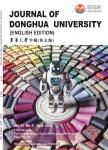Development of Composite Textile Structures for Wound Dressing Applications
Development of Composite Textile Structures for Wound Dressing Applications作者机构:Institute for Materials Research and InnovationThe University of Bolton Department of Textile EducationMarmara University
出 版 物:《Journal of Donghua University(English Edition)》 (东华大学学报(英文版))
年 卷 期:2013年第30卷第5期
页 面:447-450页
核心收录:
学科分类:0821[工学-纺织科学与工程] 0817[工学-化学工程与技术] 08[工学] 0807[工学-动力工程及工程热物理] 0805[工学-材料科学与工程(可授工学、理学学位)] 0802[工学-机械工程] 082102[工学-纺织材料与纺织品设计] 0811[工学-控制科学与工程]
主 题:nonwoven composite textile structure wound dressing carboxymethylcellulose(CMC) polylactic acid(PLA)
摘 要:The main objective of this research work was the development of novel and responsive nonwoven composite structures containing gelling materials for wound management. The development of novel all inclusive collagen booster(CB) therapeutic nonwoven wound dressings was mainly focused on. It provides essential functional properties such as high absorption,vertical and lateral wicking,and antibacterial and acidic pH properties. The developed composite wound dressing consisted of carboxymethylcellulose(CMC) fibre and also it was reinforced with polylactic acid( PLA) fibre. The produced composite wound dressings were treated with two different CBs at 4% by using the spray method. The details of the CBs have not been disclosed in this paper due to the Intellectual Property Rights( IPR) issues. The important benefit of using CB treatment is that it allows the maintenance of an acidic pH environment at the wound area. It is well known that acidic pH reduces the wound healing time and enhances the wound healing process. Furthermore,one of the CBs not only promotes the proliferation of the epithelial cells in wounds but also can provide antibacterial action. The PLA fibre reinforced CMC composite dressing has enhanced wicking properties which help to minimise the pooling of exudate on the wound bed and as a result maceration is prevented. The CBs treated dressings maintain the wound bed in an acidic pH condition which also improves the wound healing process. In addition to the above-mentioned properties,the CB treatment imparts antimicrobial activity against Gram-positive and Gram-negative bacteria,thus resulting in the reduction in the propensity for wound infection. Ultimately,the research has proved that the 4% CB treatment enhances the antimicrobial activity and the acidic pH characteristics of the developed CMC /PLA composite wound dressings.



